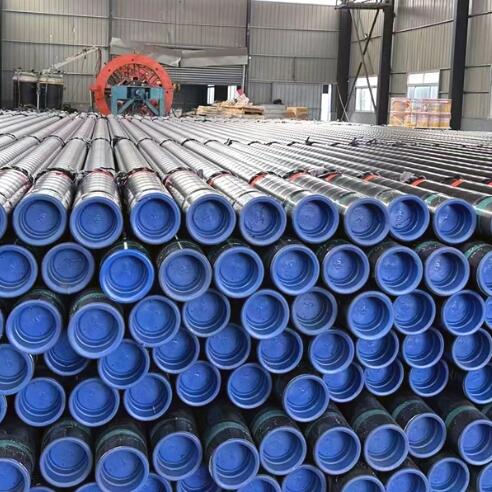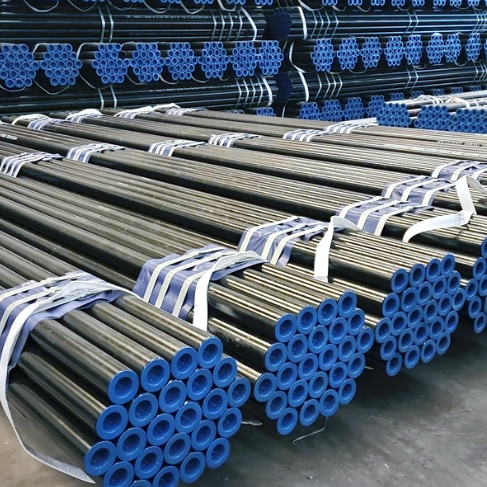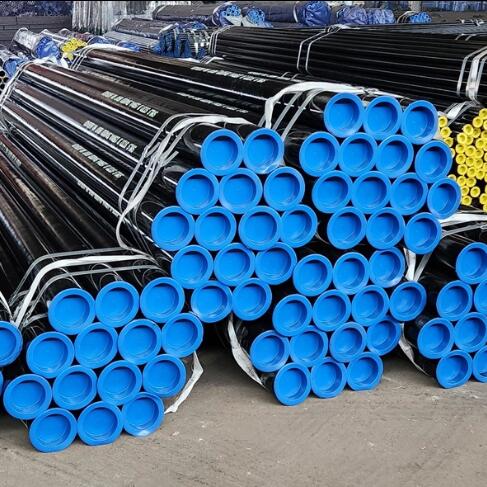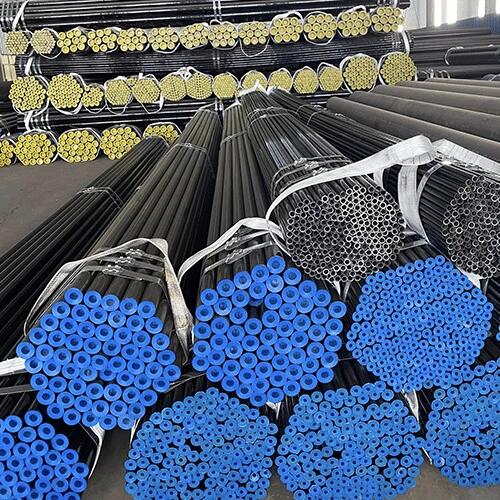Steel pipe manufacturers introduce to you the defects of cold drawing of DIN 17456 seamless pipes.
1. Fold
Exists on the outer or inner surface of cold-drawn DIN 17456 seamless pipes, in a linear or spiral shape, continuous or discontinuous. The main reason for folding is that the quality of the pipe material is poor, there are folds in the pipe itself, or there are inclusions, serious scratches and cracks on the surface, there are edges and corners in the grinding area, and folding occurs after stretching after drawing. In order to avoid folding, the quality of pipe materials should be improved and attention should be paid to inspection and grinding.
2. Cracks (including cracks and hair lines)
Cracks refer to small cracks distributed in straight lines or spirals on the inner and outer surfaces of cold-drawn seamless pipes, with a depth of 1 mm or more, and may be continuous or discontinuous. The reasons are: there are subcutaneous bubbles and subcutaneous inclusions in the hot-rolled tube blank, there are cracks or deep pitting on the steel tube before drawing, and there are longitudinal scratches or scratches during hot rolling or cold drawing operations. . Preventing the formation of cracks also lies in improving the quality of pipe materials and strengthening the inspection and grinding of pipe materials. At the same time, pitting, scratches and scratches on the pipe during the cold drawing production process should be avoided.
3. Dimples
Pits are local depressions of varying areas distributed on the surface of cold-drawn seamless pipes. Some of the distributions are periodic and some are irregular. The pits are caused by oxide scale or other hard dirt being pressed into the surface of the steel pipe during the drawing or straightening process, or the warping that originally existed on the surface of the steel pipe is peeled off. Measures to prevent pits are to carefully inspect the pipe material and remove defects such as warped skin, keep the work site, tools and lubricants clean, and prevent oxide scale and dirt from falling on the surface of the steel pipe.
4. Diameter out of tolerance
The main reason for the diameter deviation is improper mold matching or neglect of changes in the dimensions of the extubation mold due to wear. Excessive straightening roller reduction during the straightening process will also cause the diameter of the steel pipe to become smaller.
5. Wall thickness out of tolerance
The main reasons for the wall thickness deviation are improper mold matching of cold-drawn seamless pipes, or neglecting the changes in mold dimensions due to wear, incorrect estimation of wall thickness changes in air-drawing passes after fixing the wall, and using arc. The position of the mandrel is improperly adjusted when drawing the outer mold and the tapered mandrel with short mandrels - too far forward or too far behind. In order to prevent the wall thickness from being out of tolerance, the mold should be correctly matched and the position of the mandrel should be adjusted correctly. The wall thickness changes of the steel pipe during the air-drawing passes should be estimated accurately.
6. Ellipse
That is, the cross-section of the cold-drawn seamless pipe is oval. During the drawing process, a drawing die with an oval die hole is used, or the two ends of the steel pipe are bent too much during straightening, and the steel pipe moves up and down during the straightening process, the outer diameter of the steel pipe is too large, and it gets stuck when pushing, or the tail of the steel pipe Excessive swing and uneven distribution of reduction between pairs of straightening rollers will cause this defect. If defects occur due to elliptical mold holes, the pipe mold should be replaced. If the ellipse is formed during the straightening process, the causes of the ellipse during straightening should be eliminated.
7. Uneven wall thickness
The main reasons for the uneven wall thickness of cold-drawn seamless pipes are: excessive uneven wall thickness of the pipe material, the axis of the drawing line and the steel pipe is inconsistent during drawing, and the die holes of the mandrel and the drawing die are elliptical. In order to reduce the uneven wall thickness of the steel pipe, the uneven wall thickness of the pipe material should be as small as possible. At the same time, the mold should be carefully checked and the pipe extruding machine should be adjusted.
8. Unplug
The main reasons for pullout are: excessive deformation, poor quality of heat treatment, pickling and lubrication, the hammer head does not meet the requirements, overheating or overburning occurs during heating in front of the hammer head, and the axis of the drawing line and the steel pipe is inconsistent. , the short mandrel extends out of the sizing belt of the extrusion die, the extraction speed is too fast, etc. In order to prevent pull-out, the size and mold matching of the steel pipe before drawing should be strictly in accordance with the regulations of the drawing table. The drawing mold should be in an upright position, the position of the mandrel should be correct, and the quality of each preparation process before drawing should be ensured. When the control speed is high, the speed should be reduced when pulling out.
9. The drawing head of short mandrel is too long during drawing.
When drawing short mandrel rods, it is normal for there to be a short drawing head on the steel pipe with a wall thickness greater than the specified drawing wall thickness. However, if the air-pulling head is too long, the amount of head cutting will increase and the metal consumption will increase. The reason why the undrawn head is too long is that the mandrel is not pushed in time during drawing or the mandrel cannot be brought into the deformation zone by the steel pipe. When the former situation occurs, you should pay attention to the operation and use of the locator. If the mandrel cannot enter the deformation zone, you can polish the chamfer at the end of the mandrel on a grinding wheel to make it easier to bring it into the deformation zone.
10. Shake lines
It only occurs when drawing short mandrels. When chatter marks appear, there are wavy ring marks of varying heights and numbers on the inner surface or the inner and outer surfaces of the steel pipe. Some are continuous, some are intermittent, and may or may not be a full circle. Therefore, the vibration marks are caused by the vibration of the steel pipe and the mandrel rod during the drawing process. The specific causes of jitter are: poor quality of pickling and lubrication, increased and changing friction during drawing, inconsistent mechanical properties along the length of the steel pipe after heat treatment, too long and thin mandrel rods, too forward or backward position of the mandrel, and Excessive deformation, etc. In order to prevent the occurrence of chatter marks, the quality of pickling, lubrication and heat treatment should be improved, the position of the mandrel should be adjusted correctly, and the use of mandrel rods with too thin diameter should be avoided.
11. Longitudinal cracking
When this kind of defect occurs, the steel pipe will show longitudinal cracks that penetrate the pipe wall and have sudden occurrence. It usually occurs along the entire length, sometimes at the end near the hammer head. Longitudinal cracking usually only occurs in drawn steel pipes because there is a large tangential tensile residual stress on the outer surface of the steel pipe after drawing. The specific reasons for longitudinal cracking are: the diameter reduction is too large, the degree of uneven deformation is aggravated, and the residual stress is increased; there are too many consecutive pulling passes during air drawing, resulting in large residual stress and work hardening of the steel pipe; improper annealing Including the temperature is too low, the temperature is uneven or the time is too short; the local dent in the pipe wall in the transition part behind the hammer head is too deep or the tail end of the steel pipe after drawing is uneven and has notches, causing stress concentration; the pipe is not baked or annealed in time after drawing And it was impacted when put aside; the surface of the steel pipe had defects such as folding and hydrogen embrittlement. The cold working properties of steel are poor, the steel pipe wall is thicker and the temperature is low, and the tendency of longitudinal cracking is greater when the pipe is pulled out. Longitudinal cracking of steel pipes is an irreparable defect. Once it occurs, the steel pipes will be scrapped. To prevent longitudinal cracking of steel pipes, the diameter reduction amount and the number of continuous drawings in air drawing passes should be controlled to ensure the quality of heat treatment and hammer heads to avoid hydrogen embrittlement. The steel pipes after drawing should be annealed in time.
12. Longitudinal concave folds in the pipe wall
It occurs when air-drawing thin-walled and extra-thin-walled pipes. It is caused by the loss of stability of the steel pipe cross-section during the drawing process of cold-drawn seamless pipes. The specific reason is that the diameter reduction is too large. If the pipe wall at the transition portion of the hammer head is too deeply recessed, there will also be a tendency for longitudinal dents. In order to prevent longitudinal dents when drawing thin-walled and extra-thin-walled pipes, the diameter reduction should be smaller and the quality of the hammer head should be good. Double-die drawing can also be used.
13. Warped skin
It is characterized by thin flakes that are partially separated from the metal matrix on the inner and outer surfaces of the steel pipe. Some of them are lumpy and discontinuous. They may or may not take root on the pipe wall, but they cannot peel off naturally. The reasons are: 1) The steel is of poor quality, with subcutaneous bubbles, which are exposed after cold drawing. 2) The warping strips produced during hot rolling are transferred to cold drawing. 3) The original deep and angular transverse pits on the steel pipe have After pulling, the skin becomes warped.
14. Inclusions
It manifests itself as non-metallic inclusions embedded in the surface or surface cracks of cold-drawn seamless pipes. The reason is that the steel is of poor quality or impurities are pressed into the surface when the tube blank is heated or the steel tube is annealed.
15. Ma Mian
Its characteristic is that the surface of the cold-drawn seamless pipe presents patches of small, point-like pits. The main cause of pitting is pitting corrosion during pickling. After annealing, the iron oxide scale is too thick and then straightened and pressed into the surface of the steel pipe. The steel pipe is not well preserved and rusts.
16. Hit (press) dent
Mainly produced from cold-drawn seamless thin-walled tubes. The causes are improper handling and lifting, especially excessive stacking of steel pipes when coming out of the furnace after annealing, the bottom steel pipe being dented, the steel pipe swinging during straightening, and the clamping being too tight when cutting the pipe.
17. Correction of dents
It manifests itself as a spiral mark with smooth or sharp edges on the outer surface of the steel pipe. The reasons include: the angle of the straightening roller is incorrect, the steel pipe rubs against the convex shoulder on the edge of the straightening roller during straightening, there are worn grooves on the straightening roller, and both ends of the steel pipe are bent too much.
Hebei shengtian pipe-fitting group Co., ltd.main products are seamless steel pipe, erw steel pipe, lsaw steel pipe, ssaw steel pipe etc.If you have any questions, feel free to contact us Email : [email protected].
 What are the treatment methods for steel pipe welding?
What are the treatment methods for steel pipe welding?
 What is the processing allowance of API 5L seamless steel pipes?
What is the processing allowance of API 5L seamless steel pipes?
 In what engineering are small diameter seamless steel pipes used?
In what engineering are small diameter seamless steel pipes used?
 Which Material is Used for ASTM standards Boiler Pipes?
Which Material is Used for ASTM standards Boiler Pipes?